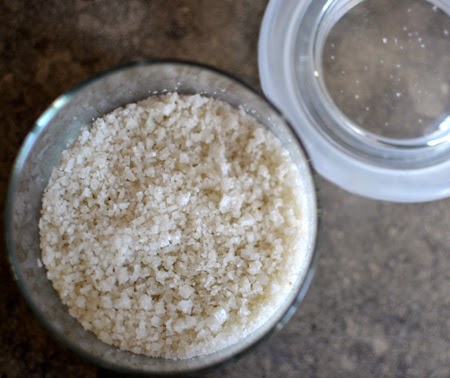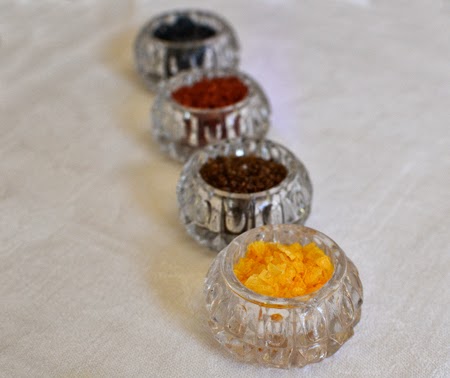I used to hate salt. My poor mother was never allowed to salt anything if she expected me to eat it.
 |
| Fleur de sel de Guérande |
That was then; this is now. Today, I consider salt a major food group. I cannot imagine my kitchen life without it! (An aside note to my blood pressure: please, please, pretty please remain normal!)
 |
| David's kosher salt |
What I didn't know when I was young is that, for the most part, salt generally permeates foods during the cooking; adding it after the fact doesn't really do anything except give you little bursts of salt with your otherwise unseasoned food. Sometimes this is what you want but, most times, not. Salt is especially necessary during the cooking of starches: potatoes, rice, pasta. Have you ever watched an Italian chef salt the water? It is done by the handful just after the water reaches boiling and before adding the pasta. As the salted water is absorbed, it gives the starch its taste.
 |
| Fleur de sel de Camargue |
When don't you salt before cooking? When cooking dried beans and legumes. They get salted at the end, lest they get tough. Also, when reducing sauces, salt lightly and season after reduction. The liquid will reduce but the salt will not - it will in fact be intensified.
 |
| Some U.S. salts - Martha's Vineyard sea salt (thanks, Susan!), truffle salt from Seattle, and Black Hawaiian (thanks, Patrician!) |
When I was young, I was aware of only one type of salt available in stores: Morton's iodized salt. To this day, I don't like iodized salt. Call me crazy, but it tastes salty without enhancing the flavors of the food. Maybe that is why I didn't like salt as a kid. I can't remember when I switched to kosher salt, but it made such a difference. It is my table salt, my standard cooking salt. Someone asked me why I prefer kosher salt over sea salt, and the answer is simple: kosher salt is readily and affordably available in large quantities. Sea salt is not.
 |
| Maldon and sel gris (thanks to the Reverend Susan!) |
That said, I have a collection of more than 20 different salts. (I am blushing with embarrassment...) If you count multiple brands of the same type - let's say truffle salt, or Maldon sea salt, or gray salt - the number increases exponentially. I have Hawaiian Red Alaea, black Turkish, Provençal sel de mer, sea salts from Martha's Vineyard and Baja, México, smoked black Hawaiian, hickory smoked, lemon flakes, coriander salt from Italy... the list goes on. Many of these are treasured gifts from friends.
Each salt I have is used in a specific way and, yes, I use them all. Why not?
Remember the Mendiant Tart with flakes of Maldon sea salt? It was one of my favorite uses of a salt in a dessert.
 |
| Porcini salt |
Recently, when I made an étouffée that called for a smoked sausage. I used smoked Durango (Colorado) sea salt because my sausage wasn't smoked. I’ve been in Durango, and didn’t notice the sea, but I digress. Nonetheless, it imparted a lovely, light smoky flavor that didn't overwhelm the dish.
 |
| Turkish black (almost blue) pyramids |
When I am garnishing little hors d'œuvres topped with sour cream, I choose a colored salt to make the nibbles look even more tempting... perhaps blue Turkish salt, or Hawaiian Red Alaea.
 |
| Cardamom salt brought back from Italy |
When adding a final flourish to risotti or meat dishes, I reach for the sel gris (gray salt) because the little zing it gives is just amazing. Sel gris, according to my friend Susan at The Modern Trobadors, happens to be Patricia Wells' and Mark Bittman's go-to salt, as well. Sel de mer is very important in Provençal cuisine, and I highly recommend that you check out her post, Aigues-Mortes: Sea Salt, Sea Salt, this week to learn more about salt harvesting and production in that region.
 |
| A really nice Alderwood smoked salt (thanks, Kevin and Kristine!) |
As I write and post recipes, I usually don't tell you when I use a really unusual salt, because I don't want you running out to find it when it really isn't necessary to flavor your meal.
 |
| Herbes de Provence salt (thanks Susan and Towny!) |
But, if someone has gifted you one of these unique salts (or a 'set' of salts), I encourage you to use them. Experiment. Taste and sense the differences - the texture, flavor, color, and how each makes you salivate just a little differently.
 |
| Coarse sel gris |
Mark's mother, Dorothy, gave me her recipe for salted oatmeal cookies. To me, they were a revelation... the caramel flavor of the brown sugar combined with the chewy oatmeal and salted tops... mmmmmm. Just heaven. And I have yet to meet someone who can eat just one.
 |
| Hickory smoked salt (thanks to my brother, Mike!) |
So there. I admit it. My name is David, and I am addicted to salt.
~ David
Dorothy’s
Salted Oatmeal Cookies
1 cup
butter
1 cup dark brown
sugar
1 egg
1 1/2 cups
flour
1/4
teaspoon kosher salt
1/2
teaspoon baking powder
1/2
teaspoon baking soda
1 teaspoon
vanilla
3 cups
rolled oats
Fleur de sel de Camargue for finishing
Cream butter and sugar; add egg and beat well.
Sift flour, kosher salt, baking powder, and
baking soda together and add to first mixture. Add vanilla and oats and mix well.
Shape dough into 1 1/4-inch logs, wrap in waxed paper, and chill for
at least 1 hour and preferably for 2 hours.
Preheat oven to 375°F. Cut logs into 3/8-inch slices and place
on greased or parchment lined cookie sheets. Sprinkle
tops generously with Fleur de sel. Bake
10 minutes.
Makes 6 dozen cookies.
 |
| Front to back: lemon flakes, Durango smoked, Hawaiian red alaea, black Cypress flakes |
Labels: alderwood, black Cypress, cardamom, fleur de sel, Hawaiian, herbes de povence, hickory, Maldon, Martha's Vineyard, porcini, red alaea, sea salt, sel gris, truffle, Turkish pyramids













